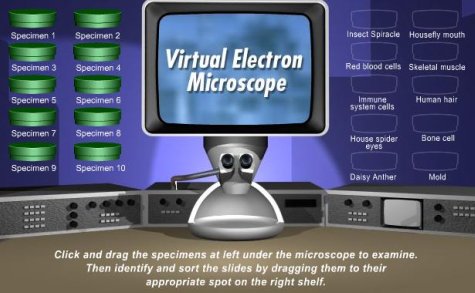The Virtual Electron Microscope
Educational Activity for Kids and Adults
A Virtual Electron Microscope provides a simulated microscope experience via a computer program or Internet website.
Electron microscopes are large, cumbersome expensive instruments that many institutions cannot afford, house or maintain.
Virtual microscopes have both educational and industrial applications and are easily operated and accessible.
Virtual Electron Microscopy
Electron microscopes (EM) are a valuable tool in science and industry; however, until the existence of virtual microscopy, these instruments have been inaccessible to many scientists and students.
A virtual electron microscope can be purchased software, a downloadable program or on a website. Virtual programs and sites can contain images produced by both transmission electron microscopes (TEM) and scanning electron microscopes (SEM).
Virtual microscopes are interactive tools and simulate the experience of using a microscope. They allow users to adjust the focus, contrast, brightness and magnification of an object.
Many electron virtual microscopes have a menu containing the different samples that can be observed. Often these are related by scientific field or theme, but can be a random group of samples.
Advantages
The benefits of virtual microscopes include:
- The ability to see objects at the most powerful magnification possible.
- They provide a wonderful learning tool.
- No maintenance of heavy equipment.
- A variety of applications such as an adjunct teaching tool, a way to share research findings and a way to train industrial workers to recognize micro-fractures in computer chips or semiconductors.
- Easy access, user-friendly.
- Ability to manipulate image with interactive controls.
- Almost anyone can use, no specialized training is necessary.
Disadvantages
Despite all the advantages, virtual electron microscopy has some limitations:
- The samples cannot be rescanned or moved to view a different area or aspect of the sample.
- Users do not gain experience in sample preparation, including the ability to recognize and minimize potential artifacts.
- There may be some discrepancy in the image depending on monitor or computer.
- Users can only manipulate images within the parameters set by the program or website.
The pros associated with TEM and SEM virtual simulations far outweigh the cons, especially when the potential applications are considered.
These include use in schools, colleges and industrial settings.
Education: Elementary and High School Applications
Most elementary and high schools do not have electron microscopes.
Before virtual microscopes, the only way for kids to see objects at nanometer magnifications was photos in a textbook.
A virtual electron microscope directed toward educational purposes can be located on-line for free use or a school can purchase software that relates to a particular scientific field or lesson.
In addition, many on-line microscopy sites developed for educational use recommend lesson plan objectives for teachers and have an easy to use interface for students.
A great website is "Discovery Education" which is very interactive. Below is a snap shot of their web page.

An adjunct teaching tool, a simulated electron microscope experience may increase interest in the sciences.
Students will interact with samples of insects, small animals, crystals, gems, computer chips and more, seeing an entire nano-world on his/her computer.
Education/Research: College Applications
Virtual microscopy can be used at colleges and universities with or without an electron microscope.
If a college does have a TEM or SEM, often students will have limited access due to the specialized training needed to operate the instrument and prepare samples.
A TEM or SEM virtual electron microscope can be a wonderful adjunct to a biology or chemistry course, providing access to images otherwise limited to those with access to an electron microscope.
In addition, with the prevalence of distance learning and on-line courses, students will be able to obtain some lab experience despite learning from home.
For colleges and universities that do have electron microscopes, virtual microscopy can be a way to share research findings.
An Internet search of virtual microscopy reveals a number of colleges post interactive virtual images, produced by professors and students.
Science and Industry Applications
A virtual electron microscope can be invaluable in the training of researchers and production workers.
TEMs and SEMs are utilized in the production of microchips, semiconductors and other technologies that require the use of extremely small parts.
A virtual microscope can be used to train employees to recognize fractures, damages, inconsistencies and other issues that may affect production.
An advanced simulation can also be used to teach employees how to use an electron microscope as well as how the microscope functions.
Similarly, researchers in almost any science field can learn how to recognize potential artifacts as well as learn how an EM produces images.
The manipulation of samples during preparation can result in potential artifacts. Most scientists can recognize these with experience; an electron virtual microscope can be a way to develop such analyzing skills.
In addition, the development of virtual microscopes can be a way for scientists to apply his/her skills. The time and training involved in becoming a proficient TEM or SEM operator can be used to prepare high-resolution images for virtual simulation.
Conclusion
A virtual electron microscope can provide a TEM or SEM experience to students, researchers or persons in industry.
Electron microscopes provide topographical, morphological and compositional information, but are expensive, cumbersome and require special training to operate.
Virtual simulation offers an alternative for those who do not have access to an EM and can be used as a classroom adjunct, training tool or a way for researchers to share microscope images.
Related article: Cryo-Electron Microscopy - is a type of transmission electron microscopy that allows for the specimen of interest to be viewed at cryogenic temperatures. Check it out.
Cryo-Electron Tomography - Resolution, Advantages and Advances
Return from Virtual Electron Microscope to Electron Microscope
Return from Virtual Electron Microscope to Best Microscope Home
Find out how to advertise on MicroscopeMaster!




